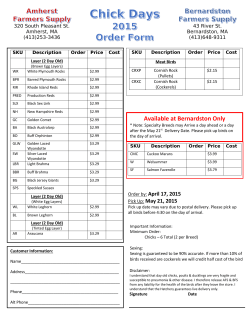
Flagellates I
Protozoan Parasites: Flagellates, Amoebae, Ciliates & Apicomplexans Spencer Greenwood BSc, MSc, PhD, DVM Dept. of Biomedical Sciences Office: 2332N AVC-North Annex Phone: 566-6002 Home: 892-4686 E-mail: sgreenwood@upei.ca http://people.upei.ca/sgreenwood/index.htm Protozoa or Protists • Single-celled eukaryotes • Heterogeneous group • Reproduction - asexual but some have sexual stages • Locomotion - flagella, cilia, pseudopods or gliding • Life style - free living & parasitic forms Parasitic Protozoa • All vertebrates & invertebrates are infected by protozoa • Life cycles: – simple & complex • Transmission: – Direct – intermediate or paratenic hosts – resistant stages (cysts) Parasitic Protozoa • • • • • • Taxonomy - major groups Flagellates Amoebae Ciliates Apicomplexa Microsporida/Myxozoa Parasitic Protozoa Eimeria Giardia Isospora Cryptosporidium Toxoplasma The Father of Protozoology Giardiasis • Zoonotic species - “Beaver Fever” • Giardia duodenalis = intestinalis = lamblia – mammals - dogs, cats, cattle, sheep & humans...wildlife – Not all assemblages are zoonotic... • Host Adapted species • G. muris – rodents • G. microti – muskrats & voles • G. ardeae & G. psittaci – birds • G. agilis – amphibians Giardia morphology - 2 life stages Axostyle Cyst Trophozoite The cyst is immediately infectious Giardia - Site of infection http://www.stanford.edu/class/humbio103/ParaSites2003/G iardia/GIARDIA2_files/image006.jpg http://www.snow.edu/~kevins/giardia.jpg http://www.deltagen.com/target/histologyatlas/atlas_files/digestive/duodenum_20x.jpg http://www.cdfound.to.it/i mg/giardia-04-250x.jpg http://www.cdfound.to.it/img/giardia-08-1000x.jpg Giardia Life cycle – simple & direct • Fecal-oral • Waterborne • Cysts highly resistant – 106 / gram of feces • Cyst = infective stage • Trophozoite = non-infectious • Prepatent period – 7-10 days Transmission Transmission Prevalence • Worldwide - found everywhere • Most common in young animals – Barnyards, kennels, catteries, shelters, puppy mills, daycares... – Stress – crowded, confinement – poor hygiene/sanitation • Dogs: – > 1 year = 4% – < 1 year = 36% • Kittens 11% • Livestock up to 100% – in calves > 30 days • Pet birds up to 60% Pathogenesis • Variable – Severity dependent on dose of infection... • Diffuse shortening of microvilli • Villus atrophy • Malabsorption • Increase G.I. motility Clinical Signs • Gastro-intestinal signs: • Most asymptomatic • Acute to chronic small bowel diarrhea – – – – Signs last ~ 1-2 weeks to months Watery explosive, Steatorrhea, pale foul smelling • Abdominal discomfort -> pain • Vomiting & anorexia http://www.petservice.com/libraries/pictures/coron_pict.html Clinical Signs • Extra-intestinal signs – Allergic response urticaria, pruritus in dogs & humans – Feather picking in birds ww w.geo citie s.com/.../ Bluffs/1 958 /pluck.h tml http://education.vetmed.vt.edu/Curriculum/ VM9144/PRURITUS/pruritus.htm Diagnosis • Gold Standard: • Centrifugal Fecal Flotation – Zinc sulphate or sucrose – with or without Lugol’s iodine stain – Scan microscope slide at 10X but confirm Dx by observation at 40X – “Osmotic artifact”- causes trophozoites in cysts to collapse • Often has a refractile edge which makes it easier to see – cysts • Intermittent shedding • Perform 3 fecal exams in 7days Osmotic artifact Refractile edge Diagnosis • Direct Fecal Smear – Fresh feces – Saline smear • Trophozoites • “falling leaf” movement • May also see cysts Diagnosis • Antigen Detection – Fecal ELISA – IDEXX SNAP® • Giardia – Based on cyst wall protein • No test 100% • Use combination – flotation & antigen to increase accuracy Treatment & Control • No licensed products – Fenbendazole, metronidazole “extra-label” – Azithromycin? – Resistance is an emerging issue? • Vaccination - Giardia Vax® Treatment & Control • Good hygiene – Cysts stick to fur... therefore remember to bathe infected pets (daily?)... – Disinfect fouled areas...long contact times • Proper sanitation • Reduce Stress Poop & Scoop Barbie Giardia in the news Hexamitosis • Hexamita meleagridis – Turkeys & game birds • Hexamita columbae – Pigeons Morphology - Hexamita • Trophozoite – oval shaped, bilaterally symmetrical with 8 flagella – binucleate with prominent nucleolus – 6 -12 um long • Cysts – “rarely formed” Wood & Smith 2005, Avian Diseases Life cycle • Direct transmission – fecal-oral, contamination of feeders & waterers – Trophozoite is infectious stage • Trophs colonize small intestine • Young birds most susceptible – 1 - 9 weeks • Asymptomatic carriers (adults) • “A problem in every commercial turkey producing area” • Heavy losses reported in outbreaks of farmed ringnecked pheasants Pathogenesis & Clinical signs • Catarrhal enteritis & atony – Swollen, bulbous, liquid filled small intestine • Diarrhea – Greenish-yellow watery & foamy • Listless, inappetence, anorexia, dehydration – convulsions & coma • Survivors - stunted Diagnosis • History – Mixing of young birds with asymptomatic carriers • Clinical signs • PM - scrapings from duodenum – Trophs – fluid – Cysts - mucus/squash prep – Stain both with Hemacolor® • Beware confounding flagellates in cecum Control & Treatment • Segregation – Remove carriers, separate adults / poults – All-in / All-out strategy • Sanitation – Remove litter with fecal matter – Disinfect building, feeders & waterers • Biosecurity • Antibiotics for secondary infections? – Food animals: chlortetracycline, tetracyclines & oxytetracyline – Pet birds: metronidazole & ronidazole VPM-122 Midterm Exam # 3 • • • • • • Thursday, March 25, 2015 Lecture 286ABC/287N 0930-1020H Covers my lectures (#16-21) Protozoan Parasites lecture notes pages, 1-57. Format – – – – Multiple choice, short answer & essay Point form is okay for answers...including the essay!!!!! Say no to drugs & no drug names on exam either! No prevalence numbers Trichomonosis
© Copyright 2025











